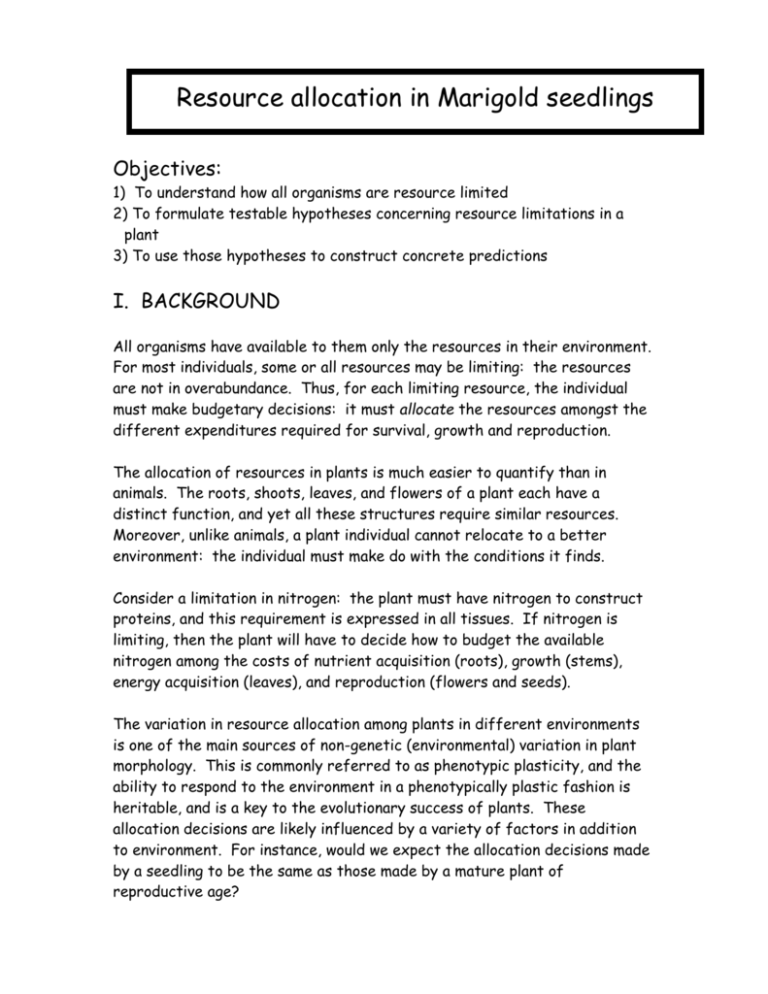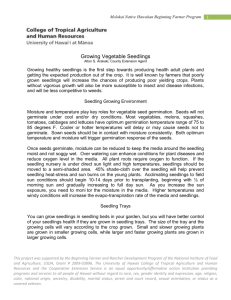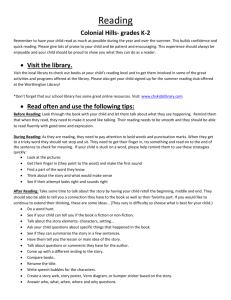i. background
advertisement

Resource allocation in Marigold seedlings Objectives: 1) To understand how all organisms are resource limited 2) To formulate testable hypotheses concerning resource limitations in a plant 3) To use those hypotheses to construct concrete predictions I. BACKGROUND All organisms have available to them only the resources in their environment. For most individuals, some or all resources may be limiting: the resources are not in overabundance. Thus, for each limiting resource, the individual must make budgetary decisions: it must allocate the resources amongst the different expenditures required for survival, growth and reproduction. The allocation of resources in plants is much easier to quantify than in animals. The roots, shoots, leaves, and flowers of a plant each have a distinct function, and yet all these structures require similar resources. Moreover, unlike animals, a plant individual cannot relocate to a better environment: the individual must make do with the conditions it finds. Consider a limitation in nitrogen: the plant must have nitrogen to construct proteins, and this requirement is expressed in all tissues. If nitrogen is limiting, then the plant will have to decide how to budget the available nitrogen among the costs of nutrient acquisition (roots), growth (stems), energy acquisition (leaves), and reproduction (flowers and seeds). The variation in resource allocation among plants in different environments is one of the main sources of non-genetic (environmental) variation in plant morphology. This is commonly referred to as phenotypic plasticity, and the ability to respond to the environment in a phenotypically plastic fashion is heritable, and is a key to the evolutionary success of plants. These allocation decisions are likely influenced by a variety of factors in addition to environment. For instance, would we expect the allocation decisions made by a seedling to be the same as those made by a mature plant of reproductive age? As you work through this lab, bear in mind that this forms the basis of the paper you will write for this course. The more time you spend now on structuring a good experiment and developing explicit protocols, the easier your final write-up will be. II. HYPOTHESES: forming testable predictions Observation: Plants grown in different places often have different morphology. Hypothesis: Differences in plant structure among genetically similar individuals are due to differences in resource allocation. Methods: We will test this hypothesis by manipulating seedling density in dwarf marigolds. You will plant the seedlings 3 weeks prior to the final data collection, and at planting time you must formulate predictions. The seeds will be planted at 5/pot or 10/pot. For ease of statistical analysis, you will need the same number of seeds in each treatment group; this will require that you plant two pots at the lower density. What variable(s) do you need to control for (keep the same) in order for the test to be valid? Predictions: Make concrete and explicit predictions about what differences you expect to find between individuals in each treatment for roots, stems, and leaves. Keep in mind the primary function(s) of each part of the plant. Roots: Stem: Leaves: Root/Shoot ratio: III. MATERIALS AND METHODS Materials: We will supply three 3.5 inch pots, potting soil, and dwarf marigold seed. Working with your partners, develop a protocol for testing your predictions. Write all steps here, being explicit about how you will plant and harvest the seedlings and what variable(s) must be kept constant across all treatments. Note that this experiment will run over several weeks, and the course instructors will be sure to water all seedlings. BE SURE TO MARK YOUR POTS !! They may be moved around during the weeks and the pots must be labeled so you can identify yours! Data collection: You will have available to you the following equipment: balance (scale) graph paper ruler calipers Working with your partners and your TA, develop a protocol for data collection, and write it down here: IV. RESULTS Before starting with your data collection, take a moment to observe the seedlings. How many of the seeds you planted have survived? Are there any apparent differences that you did not plan on measuring that now appear interesting? Are there any adjustments to your original data collection protocol that you should make? Note all of these observations and, particularly importantly, any changes in data collection protocol, here: Proceed with your data collection, being sure to follow your protocol. This is the laboratory that will form the basis of your paper, so you must make careful notes of what you do, and any errors committed. DATA: Construct two tables below, with measurements tabulated for each seedling in each treatment group. Leave room to calculate the means and variances for each measure within each treatment group (see evaluation, below). (DATA, continued): IV. EVALUATION At this point, you have two sets of numbers. You have the measurements of seedling morphology from the low density treatment, and the measurements of morphology from the high density treatment. They may or may not appear very different, but how can you evaluate those differences in a way that allows you to test your original predictions? The conundrum is, are the differences you’ve found between seedlings in each group due to chance occurrences, or are they due to the experimental treatment? Biologists use a simple statistical test, Student’s t test, to compare mean values of different groups (figure 1, lines 1 and 2), in essence testing whether the two groups are drawn from the same population or from different populations. We can use this test to determine whether the seedlings are quantitatively different between the two treatment groups. Figure 1. The vertical lines indicate the means for each of the two groups; the horizontal lines the variation in each. Clearly, to determine whether the means are different, we must have some knowledge of the amount of variation in each population. In figure 2, the means are the same, but the variance is greatly increased. With such high variance, the differences between the means appears to be much less relevant: it could be due simply to sampling error (chance sampling of different individuals from the same population). Figure 2. The means are the same as in figure 1, but the variance in each of the populations is greatly increased. To do the Student’s t-test, you must first calculate the mean and standard deviation (the square root of the variance) within each treatment group for each of the variables you measured. The mean is calculated as: __ X = (x)/n where (x)/n means “the sum of all observations (x) divided by the number of observations (n) The variance in a treatment group is calculated as s2 = (x-mean) 2/n-1 where the right hand portion means “the sum of the squares of the difference between each measurement and the mean in that treatment divided by the number of observations in that treatment minus 1” The standard deviation (s) is the square root of the variance. When the variance is the same in both treatment groups, then the student t test is calculated as __ ___ t = X 1 – X2 / √[(s12+s22)/2] For this experiment we will assume that the variance is the same. The denominator in this calculation of t is the pooled variance across both treatments, when sample sizes are the same. IF sample sizes in the two treatment groups are not the same (i.e., you had some seed or seedling mortality in one group), then randomly sample within the larger treatment group to achieve equal sample sizes between the two groups. Place your calculations here: Final steps: Evaluate your predictions. Considering your results, do your data cause you to accept or to reject your predictions? If you reject your predictions, how does this affect your initial hypothesis?







